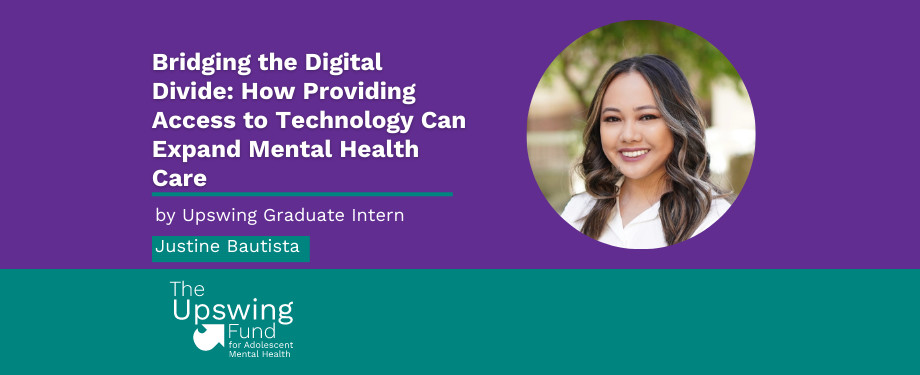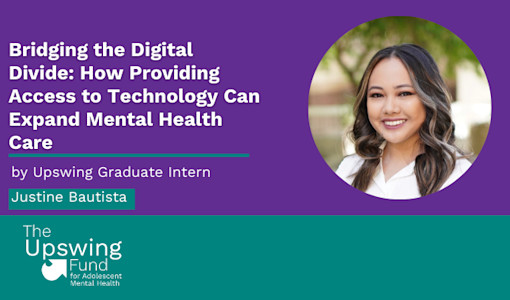

April 10, 2023 | Articles
Bridging the Digital Divide: How Providing Access to Technology Can Expand Mental Health Care
Digital mental health has become increasingly popular, providing a variety of mental health services that can be accessed via digital devices like smartphones, tablets, and computers. As the pandemic has accelerated the adoption of telehealth services, digital mental health has become an essential resource. However, not everyone has equal access to those resources due to the digital divide.
Defining the digital divide
Simply put, the digital divide is the gap between those who have access to digital technologies, such as devices and infrastructure, and those who do not. When it comes to digital mental health, this divide can make or break access to much-needed services for communities that otherwise would not receive mental health care. However, it's important to note that the divide isn't just a question of access but also the skills and ability to use digital tools in effective ways. This lack of digital literacy can prevent people from taking full advantage of the benefits of digital technologies, including access to digital mental health services. Additionally, it's worth exploring why the digital divide exists and where it is the widest. In many cases, factors such as income, education, and geographic location can all contribute to a lack of access to digital technologies. For example, individuals living in rural areas may not have access to the same level of digital infrastructure, such as software systems, mobile apps, and broadband access, as those in urban areas. Without addressing these underlying factors, the digital divide is likely to persist and continue to limit access to much-needed mental health services for underserved communities.
Impacts of the digital divide on understudied communities
Rural communities, often geographically isolated, face a lack of accessible mental health resources Throughout the United States, rural communities are also less likely to have access or skills to use digital tools. This digital divide further compounds existing barriers to mental health care by limiting access to telehealth services, access to providers, and a lack of digital devices.
Little work has been done to create digital mental health solutions tailored to rural communities, though the need is significant. Similarly, though digital mental health tools exist for BIPOC youth and for other marginalized groups, there is significant underrepresentation of Asian Americans in both these tools and in digital mental health at large. Across Asian American communities, culture and mental health stigma play a key role in limiting access to mental health services. Services provided virtually can provide much needed anonymity and encourage individuals to seek help when they need it.
Digital mental health services can provide an alternative to traditional mental health care that addresses some of the key barriers mentioned above: increased accessibility for communities with limited options, and anonymity for communities facing cultural stigmas.
Community-based solutions
Community-based organizations (CBOs) are key to increasing access to mental health services in communities that face significant barriers. By partnering with mental health providers and digital health companies, CBOs can help individuals navigate the complexities of the healthcare system and provide them with the necessary resources to access digital mental health services. In addition, CBOs can serve as the conduit between youth voices and mental health app developers to build effective, user-informed digital mental health tools.
How CBOs can help bridge the digital divide
- Advocate for broadband infrastructure and providing technology training to individuals who may not be familiar with digital devices.
- Host virtual support groups and providing outreach services to connect individuals with mental health providers who offer digital mental health services.
- Break down cultural barriers by providing culturally sensitive mental health resources and education.
- Collaborate with mental health providers who understand the unique cultural and linguistic needs of different communities, such as Asian Americans, and offer digital mental health services in multiple languages.
imi: a case study in successful collaboration
Collaboration with various stakeholders can push service delivery forward and benefit communities with the greatest need. For example, imi, a new free digital mental health tool, illustrates how a partnership between multiple organizations can bridge the digital divide. Informed by hundreds of BIPOC and LGBTQ+ youth, three organizations collaborated to develop the tool: Hopelab, a social innovation lab and impact investor, CenterLink, a nonprofit membership organization of LGBTQ+ centers across the country, and the It Gets Better Project, a nonprofit with a mission to uplift, empower, and connect LGBTQ+ youth around the globe.
As a web-based tool, imi doesn’t require youth to download an app or to use it on a smartphone — youth can use it on any internet-connected device. It is also intentionally low-cost to account for cost-related barriers, explained Fred Dillon, Head of Advisory Services at Hopelab.
“We were trying to make something that would be no cost to the end users. And because it's going to be shared by nonprofit partners, we also wanted to keep costs low related to the maintenance and updating of the content in the product.”
Spreading the word about digital mental health resources can be a struggle, but thankfully, social media platforms are able to meet youth where they are and offer an opportunity to reach a large audience quickly.
Fred went on to share, “we should not underestimate the power of social media and how you can use it to reach youth. If you are doing a really good job of curating content and putting it out there, that content can become an intervention unto itself if it is evidence-based and relevant to your audience.”
Concerns about digital mental health tools
While digital mental health offers many benefits, there are still concerns about the potential about further widening the mental health treatment gap, as well as about the privacy and security of personal health information. The treatment gap refers to the disparity between the number of people who need mental health treatment and the number who actually receive it. While digital mental health can help make mental health services more accessible, it may not be available or accessible to everyone, especially those in underserved communities or those who lack the necessary technology or internet access.
Digital mental health services also typically involve the collection and storage of sensitive personal information, including mental health diagnoses, treatment plans, and other confidential information. There is a risk that this information could be accessed or breached by unauthorized individuals, potentially leading to discrimination, stigma, or other negative consequences. Ultimately, digital mental health tools should be used as a gateway to professional support, especially for those who may not be quite ready to engage in traditional forms of mental healthcare.
Key takeaways
Digital mental health has become a crucial resource for individuals seeking mental health care, particularly in communities that lack access to traditional mental health services. However, the digital divide presents a significant challenge to ensuring that everyone has equal access to these resources.
Community-based organizations can play a key role in bridging the digital divide by advocating for broadband infrastructure, hosting virtual support groups, and providing culturally sensitive mental health resources.
Additionally, cost-related barriers can be addressed by creating low-cost digital mental health tools and leveraging social media platforms to increase their reach. Overall, it is crucial for individuals, communities, and policymakers to work together to address the digital divide and ensure that everyone has equal access to digital mental health resources. By taking action to bridge this gap, we can help to ensure that all individuals have the support they need to maintain good mental health and wellbeing.
Justine Bautista was born and raised in Orange County, CA with roots in the Philippines. Justine is also an intern at The Upswing Fund. She is currently attending the University of California, Irvine for her PhD and Master’s. Justine has leveraged her skills in research to understand how digital tools impact mental health outcomes in young people and how we can use media as a tool for creating lasting change.


